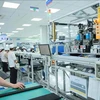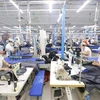Vietnam’s retail market has recently witnessed the emergence of numerous foreign businesses as they make acquisitions and expand operations. While some fear the loss of Vietnamese brand names, others believe there is still substantial room for local firms to develop.
Thai billionaire Sirivadhanabhakdi’s retail conglomerate Berli Jucker last year announced its plan to buy all 19 supermarkets of Vietnam’s Cash & Carry wing of the Germany Metro AG for nearly 880 million USD, the biggest retail acquisition in Vietnam’s history. Metro Cash & Carry Vietnam generated more than 690 million USD in revenue in 2013.
In late 2014, the Central Group of Thailand’s richest family, Chirathivat, declared that its Power Buy Company had purchased 49 percent stake in the NKT New Solution and Technology Development Investment JSC, which owns the Nguyen Kim electronic shopping centre chain – one of the top Vietnamese retailers with 21 supermarkets nationwide. Earlier in the year, the Central Group opened two Robins outlets selling high-end products in Hanoi and Ho Chi Minh City.
Over the past decade, Vietnamese consumers have also become familiar with big names from other countries such as Big C from France, Lotte from the Republic of Korea, Parkson from Malaysia, and Aeon from Japan.
A survey released in November 2014 by market research firm Kantar Worldpanel showed that 68 percent of Vietnam’s population live in rural areas and contribute to 60 percent of the national domestic product. Looking forward, their income and living standards are on the rise.
Chairwoman of the Association of Vietnam Retailers Dinh Thi My Loan said nearly all FDI businesses have poured their money into modern retail facilities such as super- and hyper-markets and shopping malls. These mega-facilities account for just 25 percent of the retail sector, leading to strong competition between domestic and foreign firms in this channel.
She added that rural areas are a largely untapped market, though a number of domestic retailers have recently been working to increase their presence in rural areas.
Meanwhile, HCM City is also seen as a lucrative market with a population of more than 7.8 million and strong purchasing power.
Local businesses such as the Saigon Union of Trading Cooperatives (Saigon Co-op), the Saigon Trading Group (Satra), and the An Phong Investment Joint Stock Company (the owner of Maximark supermarket chain) are currently dominating the city’s market. They also plan on spreading their reach to rural areas across Vietnam.
For example, the Saigon Co-op has initiated a plan to extend its operations with 28 supermarkets in HCM City and 42 others in localities nationwide along with a network of convenience and department stores.
It has also cooperated with Singapore’s NTUC FairPrice Cooperative to open Co-opXtra Plus, the first hypermarket in HCM City. An additional five hypermarkets are expected to be operational in 2015.
The General Statistics Office estimated total retail sales and customer service in 2014 at 2,945 trillion VND (over 140.2 billion USD), an annual increase of 10.6 percent.-VNA
Thai billionaire Sirivadhanabhakdi’s retail conglomerate Berli Jucker last year announced its plan to buy all 19 supermarkets of Vietnam’s Cash & Carry wing of the Germany Metro AG for nearly 880 million USD, the biggest retail acquisition in Vietnam’s history. Metro Cash & Carry Vietnam generated more than 690 million USD in revenue in 2013.
In late 2014, the Central Group of Thailand’s richest family, Chirathivat, declared that its Power Buy Company had purchased 49 percent stake in the NKT New Solution and Technology Development Investment JSC, which owns the Nguyen Kim electronic shopping centre chain – one of the top Vietnamese retailers with 21 supermarkets nationwide. Earlier in the year, the Central Group opened two Robins outlets selling high-end products in Hanoi and Ho Chi Minh City.
Over the past decade, Vietnamese consumers have also become familiar with big names from other countries such as Big C from France, Lotte from the Republic of Korea, Parkson from Malaysia, and Aeon from Japan.
A survey released in November 2014 by market research firm Kantar Worldpanel showed that 68 percent of Vietnam’s population live in rural areas and contribute to 60 percent of the national domestic product. Looking forward, their income and living standards are on the rise.
Chairwoman of the Association of Vietnam Retailers Dinh Thi My Loan said nearly all FDI businesses have poured their money into modern retail facilities such as super- and hyper-markets and shopping malls. These mega-facilities account for just 25 percent of the retail sector, leading to strong competition between domestic and foreign firms in this channel.
She added that rural areas are a largely untapped market, though a number of domestic retailers have recently been working to increase their presence in rural areas.
Meanwhile, HCM City is also seen as a lucrative market with a population of more than 7.8 million and strong purchasing power.
Local businesses such as the Saigon Union of Trading Cooperatives (Saigon Co-op), the Saigon Trading Group (Satra), and the An Phong Investment Joint Stock Company (the owner of Maximark supermarket chain) are currently dominating the city’s market. They also plan on spreading their reach to rural areas across Vietnam.
For example, the Saigon Co-op has initiated a plan to extend its operations with 28 supermarkets in HCM City and 42 others in localities nationwide along with a network of convenience and department stores.
It has also cooperated with Singapore’s NTUC FairPrice Cooperative to open Co-opXtra Plus, the first hypermarket in HCM City. An additional five hypermarkets are expected to be operational in 2015.
The General Statistics Office estimated total retail sales and customer service in 2014 at 2,945 trillion VND (over 140.2 billion USD), an annual increase of 10.6 percent.-VNA



















